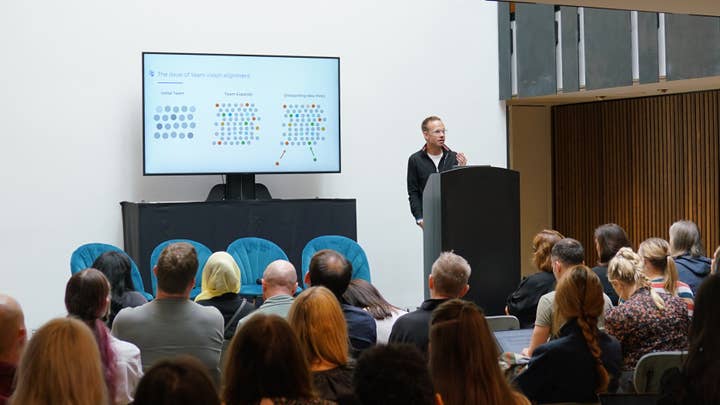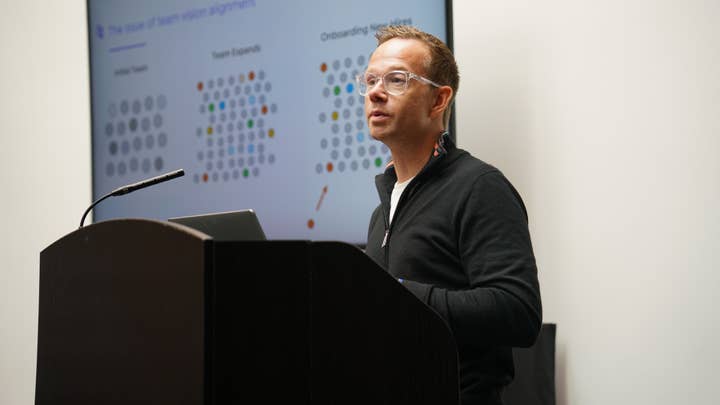Identifying the human problems behind the lack of a clear vision in games development
Organisational psychologist Graham McAllister highlights the importance of maintaining game vision alignment
At the GamesIndustry.biz HR Summit in September, organisational psychologist Graham McAllister presented a talk entitled 'Game vision alignment: Its role in team effectiveness,' exploring how studios can improve their games by maintaining a clear vision of what they're creating.
McAllister previously founded Player Research in 2012, a user research and playtesting studio, which he left in 2019. He then founded TeamSync, a studio specialising in keeping teams aligned during development.
After asking what three things the audience thought would increase the chances of a studio's success, McAllister suggested that a creatively aligned team is the most significant indicator of success.
The focal point of McAllister's talk was highlighting the importance of game vision alignment, but he also gave insight into how a studio can determine whether they are aligned and, if not, what they can do to change that.
What makes a successful development team?
During his talk, McAllister referred to the Games Outcomes Project – a large-scale survey of game developers conducted between October and November 2014. While being almost ten years old, this project highlighted ideas that are still relevant to this day.
He specifically highlighted part five of the project during his talk, where participants were asked how they worked as a team and the outcome. The report listed 40 factors in order of significance based on the responses received, and top of the list was "having a well and clear-communicated vision."
Below are the top five findings:
Great development teams…
- "Have a clear, shared vision of the game design and the development plan and an enthusiasm for that vision"
- "Are cautious about making changes in development that deviate too far from the vision"
- "Have team members that buy into the decisions that are made"
- "Avoid crunch and extended overtime"
- "Build an environment where it's safe to take a risk and stick your neck out to say what needs to be said"
During his time at Player Research, McAllister often asked studios the simple question of what game they were making. The answers would vary across the staff, including the studio's creative director, CEO, and lead designer.
"I always thought: 'That's interesting, they don't seem to know what game they're making," McAllister noted.
He went on to say that this observation, along with the data collected in the survey, were two of the first things he found to prove that a lack of vision when creating a game was a major issue.
More broadly, he found that it wasn't just "a problem in the games industry, but is the problem in the games industry."
How can the vision of a game be lost?
McAllister started his talk by explaining how losing game vision alignment usually occurs when a studio starts to grow – that the more people that are added, the more chance there is for a vision to be lost.
"Usually, at the beginning, the team is quite small," he explained. "The myth in the gaming industry is that the vision of the game at that stage is quite clear. It's a small number of people that have been working on it for a while, saying: 'We know what we're making, we know what we're doing.'
"But as soon as the studio expands, variations of the vision occur within the team, and these variations become very strong."
He added: "Depending on the person being onboarded and the person doing the onboarding, their identities and organisational storytelling can inadvertently change the game."
McAllister highlighted that when games are externally developed with collaborations across several studios, it's easy for the game's vision to be lost – primarily when it's being handled by different teams who are often based in other countries.

"It's worse when you add in a publisher, a co-developer and investors," he continued. "There aren't as many people as you go up the hierarchy, but the problem is the force that they exert is absolutely enormous. And if this person is paying for the game, they tend to get what they want.
"This is the problem with team alignment – there's alignment within the company, then there's this external force with a vision that transmits across boundaries, and that transmission brings its own problems."
When there is a set and clear vision of what a game is supposed to be during development, the studio benefits greatly from it.
"There's no conflict in the team, less delays, good communication, a very focused player experience, and people being healthy and happy by making the game," McAllister noted. "And the culture is good in the studio that more people will want to join."
What happens when there's a lack of vision?
When there is a problem with game vision alignment among a development team, the game suffers as a result. McAllister detailed several examples, including BioWare's Anthem.
In his talk, McAllister cited a 2019 report by Kotaku exploring what went wrong with Anthem, featuring interviews from developers who explained the internal issues within the studio and why the game launched in a largely unfinished state.
"Because we don't know what we're making, that's why we're getting conflict"
"If you read that article, you'll see that all the problems surrounding the making of Anthem were mostly all human problems," McAllister explained, highlighting that a lack of vision was the source of these issues.
"The staff reported that yes, they had friction, they had conflict. But the root cause was: 'We don't know what we're making. And because we don't know what we're making, that's why we're getting conflict. And because we're getting conflict, we're seeing all these other things, like people crying in the car park [from stress]'."
McAllister summarised that this is also the root cause of failed launches and other issues, such as crunch culture.
"All those things happened because of the lack of vision," he said. "Yes, you can fix those, but you have to address the underlying problem [of vision alignment], which is what you really want to fix."
How do studios fix the problem of a lack of game vision alignment?
According to McAllister, there isn't a simple answer for fixing misalignment in a game's vision. He highlighted that it's less a games industry problem, and more of a human problem.
Investigate the causes of human error
Looking into the cause of human error can help studios determine what went wrong to cause a lack of vision during development.
"Whenever you investigate human error, always start at the far end of the axis," McAllister said. "Don't start by investigating what went wrong inside a studio. At the far end, in our industry, it falls to leadership."
In the current climate of layoffs and studio closures, McAllister noted that leaders aren't prioritising vision alignment if they were to build a new studio.
"There's posts on LinkedIn from people saying, 'Well, if I was starting a studio again, here are the things I would do, here's the lessons I've learned," he noted. "When I read those lists, I've never seen vision alignment being proritised.
"As a leader, your main job is to set the conditions for success. Your job is to set the conditions for that thing to succeed, and then steer [it] in the right direction. And yet people who are espousing their 'lessons' – there's no real evidence to any of that, it's just an opinion of what they saw."
McAllister added: "Although we're talking about vision alignment today, alignment of the past – that's an interesting problem. Because what each person sees, what was the reason for our failure in the past, is not the same. That's also an alignment problem."
Address communication issues
While there may not be a simple answer for studios to address a misaligned vision within their teams, McAllister found that language was often a problem.
"People think they're communicating when they're talking – but they're not," McAllister noted. "Words are ambiguous, that's the problem. And they're ambiguous because we're different. You have a different identity, different culture, you've got different experiences and there's nothing we can do about that – but because of that we're interpreting things differently."
Implement a shared mental model
While McAllister said there is "no way of actually checking vision alignment," acknowledging team members' thoughts and how that affects their shared vision of a game is a good starting point.
"A mental model is what's inside my head and what's inside your head," he explained. "But a shared mental model is what's inside our head. Each person has an individual mental model of the game they're making or what their team is doing. A shared mental model is crazy; you have no idea what's inside it. That's why I designed a shared mental model for deconstructing a game."
"Each person has an individual mental model of the game they're making or what the team is doing"
Using a shared mental model within a game design team is a way of "structuring your thoughts and organising what's going on inside your head," McAllister noted.
"If we want to check what we're doing, we need to see what's inside your head. But how do you actually do that? What is the mechanism for saying: 'Are we agreeing? How do you know if we're agreeing?"
Before working with a studio, McAllister would ask if they were aligned, and they'd tell him they had a shared, clear vision. This would be a red flag for him because, most often, they didn't. Instead, he said they should be asking how much they are misaligned.
Ultimately, McAllister's talk emphasised that solving the misalignment isn't the only priority; it's also about acknowledging it, then communicating with each other to get everyone on the same page before the game is even in the development stage.

